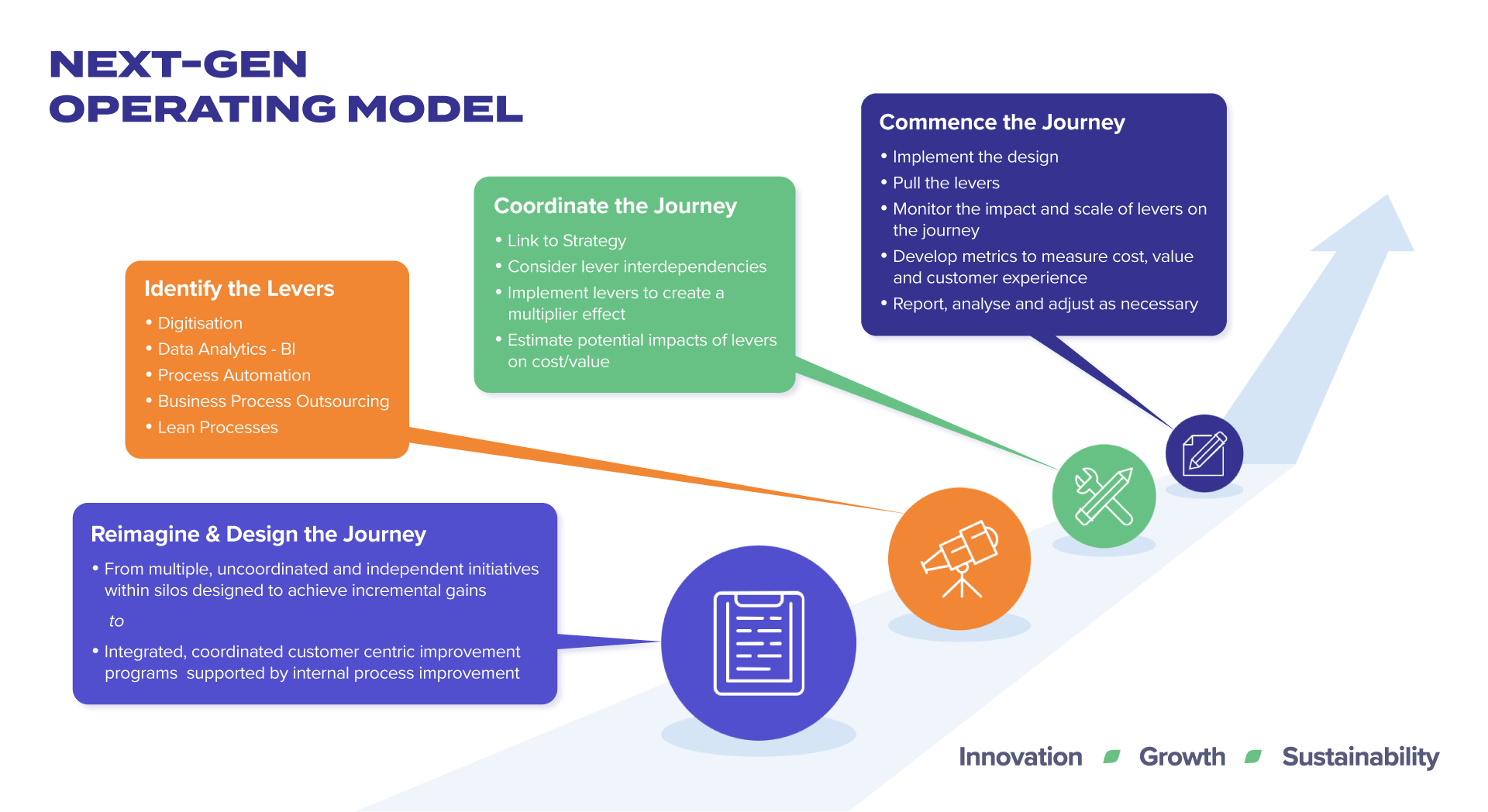Next generation operating model
The problem is that while most organisations are trying to achieve more, the reality is they often fall short of achieving those aims through:
- one-off initiatives in separate business units that do not result in organisation-wide impacts;
- isolated attempts at improvements linked to ‘what’s trending’, which almost always produces disappointing results; and
- programs and projects that provide temporary gains as opposed to sustainable value.

Traditional business/operating models are being replaced as technology, artificial intelligence and robotics become more commonplace. For organisations to build sustainable value and deliver compelling customer experiences, they need to consider implementing a Next-Gen operating model. Next-Gen operating models combine digital technologies and operations capabilities in an integrated, coordinated way to achieve sustainable improvements in revenue, customer experience, and cost reduction.
Next-Gen operating model journey – interaction and change management
Transitioning to a Next-Gen operating model will require some organisations to adopt major changes in the way they work.
Integration
Firstly, a shift from uncoordinated efforts within silos to launching integrated, organisation-wide improvement programs focused on the customer’s journey (the interactions a customer has with an organisation when purchasing or receiving services) as well as internal journeys such as the processes inside the company.
Coordination
Second is a shift from using individual technologies, operational capabilities and approaches in a fragmented manner, inside silos, to applying them in combination and in the right sequence to achieve holistic impacts.
Organisations should avoid falling into the trap of simply trying to improve existing processes. Reimagining the customer experience often reveals opportunities to simplify and streamline processes to unlock value.
Implementing levers to create value
Next-Gen operating models are leveraging the value created through five key levers that that are challenging contemporary ways of thinking and working.

Process Outsourcing (PO) uses resources outside of the main business to complete specific tasks or functions. PO typically works best for processes that are manual, are not primarily customer facing, and do not influence or reflect key strategic choices or value propositions.
Process Automation (PA) is emerging technology that combines process redesign with robotic process automation and machine learning. PA can replace human effort in processes that involve aggregating data from multiple systems or from manual documents to input data. There are also automation approaches that can take on higher-level tasks.
Data Analytics involves processing data using digital tools to discover insights, opportunities and make recommendations. It provides intelligence to improve decision making and can facilitate discussion and debate where holistic thinking is required.
Digitisation involves using technology to improve the journey. Digital tools have the capacity to transform customer-facing engagement, through avenues such as self-service. Digitisation can also redesign time-consuming transactional and manual tasks, especially when multiple systems are involved.
In considering which levers to use and how to apply them, it’s important to think in a holistic way, keeping the entire journey in mind – three design considerations are crucial:
Ensure that each lever is used to maximum effect
Management needs to be vigilant, challenging the organisation to maximise the value attained through levers. This will help to avoid complacency and identify learnings that could drive improved performance.
Implement each lever in the right sequence
There is no universally correct sequencing for levers due to the variables in each organisation. Value is created when scenarios and interdependencies are considered and the levers build on each other.
Levers should interact to create a multiplier effect
Develop ‘road maps’ to provide an organisation-wide view of the scale of opportunities and the potential impact of interacting levers. Consider value metrics including cost, customer experience and productivity.
Transforming theory into practice
Senior leaders and managers have a critical role in transforming theory into practice. Next-Gen operating models can only overcome organisational lethargy and trigger improvements with buy-in from all key stakeholders.
By focusing on, and delivering, a few ‘quick wins’ initially, the value of the Next-Gen operating model can be proven. Once proven, internal capabilities and capacity can be evaluated to understand how the journey needs to be resourced – internally and potentially with outside assistance.
Implementing the model comes next. Transformation value cannot be created in silos. The success of the Next-Gen operating model comes from combining improvement efforts around customer-facing and internal journeys with the cohesive application of processes and capabilities.
Talk to us about how we can help you to implement a Next-Gen operating model within your company to improve performance.

